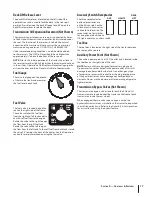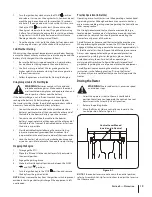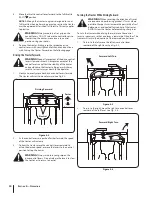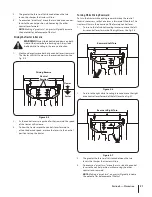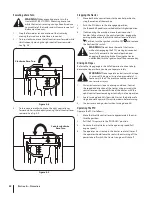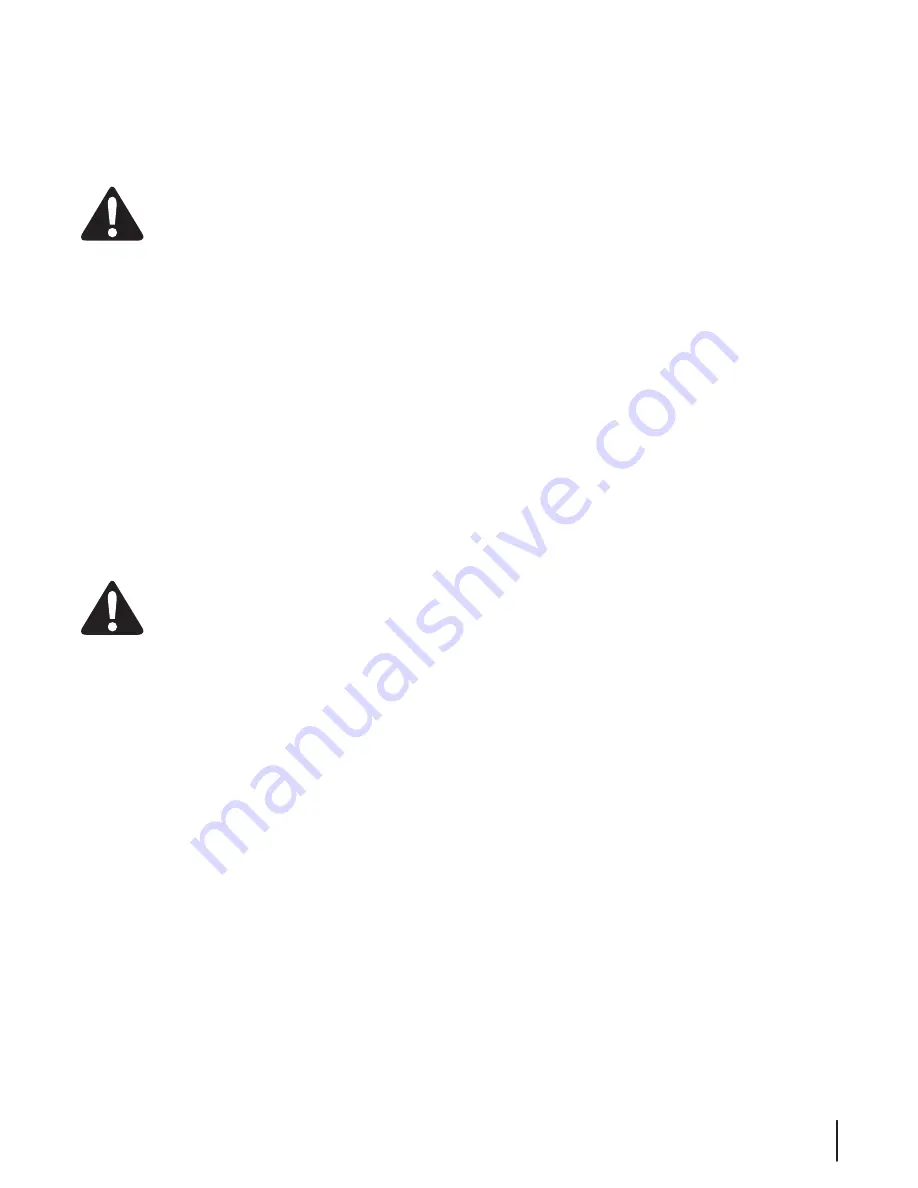
7
S
ection
2 — i
mportant
S
afe
o
peration
p
racticeS
Hydraulic Devices and Systems
Hydraulic fluid escaping under pressure may have sufficient
force to penetrate skin and cause serious injury. If foreign fluid is
injected into the skin or eyes, see immediate medical attention or
gangrene and permanent damage may result.
WARNING:
Keep body and hands away from
pinholes or nozzles that could inject hydraulic fluid
under high pressure. Use paper or cardboard, not
your hands, to search for leaks! Wear gloves and
safety glasses.
Safely relieve all pressure in the system before performing any
work on the system, and make sure that:
•
The ignition switch is OFF
•
The key is removed
•
The engine spark plug wire(s) removed
•
All connections to the negative terminal of the battery are
removed
•
The park brake is set
•
All by-pass valves, if so equipped, are open
•
Hydraulic controls are actuated to release pressure on
pumps, cylinders, etc. If “float” positions are available, they
should be used
.
After the above operations are completed, it should be safe to
begin disconnecting the lines or components. It is still a good
idea to cover the connection with a cloth shield and then gently
loosen connections.
WARNING:
Make sure all hydraulic fluid
connections are tight and all hydraulic hoses and
lines are in good condition before applying pressure
to the system.
Service
Safe Handling of fuel
1.
To avoid personal injury or property damage use extreme
care in handling fuel. Fuel is extremely flammable and the
vapors are explosive. Serious personal injury can occur
when fuel is spilled on yourself or your clothes which can
ignite. Wash your skin and change your closes immediately.
a. Use only approved containers.
b. Never fill containers inside a vehicle or a truck or
trailer bed with a carpeted or plastic liner. Always
place containers on the ground away from your
vehicle before fueling.
c. When practical, remove machines from the truck or
trailer and refuel it on the ground. If this is not possible,
then refuel equipment on a trailer with a portable
container rather than from a fuel dispenser nozzle.
d. Keep nozzle in contact with the rim of the fuel tank
or container opening at all times until fueling is
complete. Do not use a nozzle lock-open device.
e. Extinguish all cigarettes, cigars, pipes and other
sources of ignition.
f.
Never fuel machine indoors or near ignition sources.
g. Never remove fuel cap or add fuel while the engine
is hot or running. Allow engine to cool at least two
minutes before refueling.
h. Never over fill fuel tank. Fill tank to no more than ½ inch
below bottom of filler neck to allow space for expansion.
i.
If necessary, use a funnel to avoid spillage.
j.
Replace fuel cap and tighten securely.
k. If fuel is spilled, wipe off the engine and equipment.
Wait 5 minutes before starting the engine.
l.
To reduce fire hazards, keep machine free of grass,
leaves, or other debris build-up. Clean up oil and fuel
spillage and remove any fuel soaked debris.
m. Never store the machine or fuel container inside
where there is an open flame, spark or pilot light
as on a water heater, space heater, furnace, clothes
dryer or other gas appliance.
General Service
1.
Never run an engine indoors or in a poorly ventilated area.
Engine exhaust contains carbon monoxide, an odorless,
and deadly gas.
2.
Before cleaning, repairing, or inspecting, make certain the
blade(s) and all moving parts have stopped. Disconnect the
spark plug wires and remove the key from the ignition to
prevent unintended starting.
3.
Periodically check to make sure the blades come to
complete stop within approximately (7) seven seconds
after operating the blade disengagement control. If the
blades do not stop within this time frame, your machine
should be serviced.
4.
Never tamper with the safety interlock system or other
safety devices.
5.
Regularly check the safety interlock system for proper
function, as described later in this manual. If the safety
interlock system does not function properly, have your
machine serviced.
6.
Check brake operation frequently as it is subjected to wear
during normal operation. Adjust and service as required.
7.
Check the blade(s) and engine mounting bolts at frequent
intervals for proper tightness. Also, visually inspect blade(s)
for damage (e.g., excessive wear, bent, cracked). Replace the
blade(s) with the original equipment manufacturer’s (O.E.M.)
blade(s) only, listed in this manual. “Use of parts which do
not meet the original equipment specifications may lead to
improper performance and compromise safety!”
8.
Mower blades are sharp. Wrap the blade or wear gloves,
and use extra caution when servicing them.
9.
Keep all nuts, bolts, and screws tight to be sure the
equipment is in safe working condition.
10.
After striking a foreign object (or if abnormal vibration
occurs), stop the blades and engine and thoroughly inspect
the machine for any damage. Make necessary repairs
before resuming operation.
11.
Never attempt to make adjustments or repairs to the
machine while the engine is running.

















